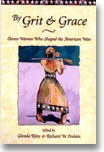 |
||||||||||
 |
||||||||||
 |
||||||||||
 |
||||||||||
|
Search
|
||||||||||
|
Titles |
||||||||||
|
|
||||||||||
|
|
||||||||||||||||||||
|
Excerpt Annie Oakley Foremost, of course, Annie’s act and image included guns. That first season with Buffalo Bill in 1885 Annie began each performance by shooting clay pigeons sprung from a trap, then shot pigeons from two traps at a time, picked up her gun from the ground and shot after the trap was sprung, shot two pigeons in the same manner, and shot three glass balls thrown in the air in rapid succession, the first with a rifle, the second and third with a shotgun. During following seasons—until she left Buffalo Bill in 1902—Oakley practiced constantly and regularly added new tricks to her repertoire. Unlike other shooters of the day who relied upon an accomplice to shatter targets by means of wires or other devices, Oakley never used tricks or illusion. Although temptations to employ artifice or cut corners must have existed, Annie and Frank strove to keep her act honest. On one occasion a circus performer who fired a rifle while swinging from a trapeze and hit the bull’s eye every time attracted Annie’s interest until she discovered that the woman fired blanks while a property man rang the bell behind the target. Similarly, in the cigar-ash trick a shooter need not come anywhere near the target; the smoker simply pulled a wire in the cigar’s center and the ash dropped off at the appropriate moment. But when Annie shot the ash off Frank’s cigarette she did so without any trickery. |
|
Reviews The remarkable range of characters portrayed in this volume is dizzying. —David B. Broad By Grit and Grace is the first offering in a new series called “Notable Westerners,” and obviously this promising series will be looking beyond Wyatt Earp, Jesse James, Sitting Bull, and other rugged males with big reputations. In this first volume, 10 historians (eight female, two male) tell the tales of 11 women, including two women with big reputations—Calamity Jane and Annie Oakley. But some of the women showcased are not big names in the West, such as Susette (1854–1915) and Susan (1856–1915) LaFlesche, Omaha Indian sisters. Susette joined the ranks of Indian reformers and lectured and wrote about injustices to the Indian people. Susan was the first Indian woman to graduate from medical school and became a medical missionary and a political advocate for the Omaha tribe. Other women with enough grit and grace to be included in the volume are LaTules, who was the leading monte dealer in the Mexican territory of New Mexico; Jessie Benton Frémont, who helped husband John find the right words when reporting on his Western expeditions; Lola Montez, a theatrical performer who made Forty-Niners forget about gold for awhile; Mary Ellen Pleasant, an entrepreneur and abolitionist; Elinore Pruitt Stewart, who was to homesteading what Martha Stewart is to good housekeeping; Abigail Scott Duniway, the mother of woman suffrage in the Northwest; and Mother Katharine Drexel, who in 1891 founded a religious community called Sisters of the Blessed Sacrament for Indians and Colored People. —Wild West magazine The editors have compiled a good selection of short biographies on the famous, including Annie Oakley and adventurer Calamity Jane, and those obscured by time, such as civil rights activist Mary Ellen Pleasant and homesteader Elinore Pruitt Stewart. In her foreword, Glenda Riley, professor of history at Ball State University, writes that this book was intended to set the record straight about the women of the West. She hoped to show that pioneer women were much more than the passive schoolmarms, housewives, or prostitutes portrayed in movies and books. And the women portrayed here were anything but passive. Two of the most fascinating were Susette and Susan LaFlesche, half-American Indian sisters from the Omaha Reservation in Nebraska. They were well educated at a time when few women, much less American Indian women, went to school. And they put their educations to good use. In the late 1870s Susette became active in the cause of the peaceful Ponca tribe, kinsmen who were removed from their ancestral home by the U.S. government. She then embarked on a successful lecture tour and became a writer at the urging of author and Colorado Springs resident Helen Hunt Jackson. Susan studied medicine and returned to the reservation to care for the Omaha. She became a crusader battling disease among the Indians, especially alcoholism, and then moved into the political sphere. This chapter is especially resonant. As written by Valerie Sherer Mathes, a professor of history at City College of San Francisco, the sisters leap off the page and out of the obscuring mists of neglect—as do so many of the subjects here, so long ignored by the mainstream history books. |
|||||
|
Fulcrum Publishing – 16100 Table Mountain Parkway, Suite 300 – Golden, Colorado 80403
|
|||||
